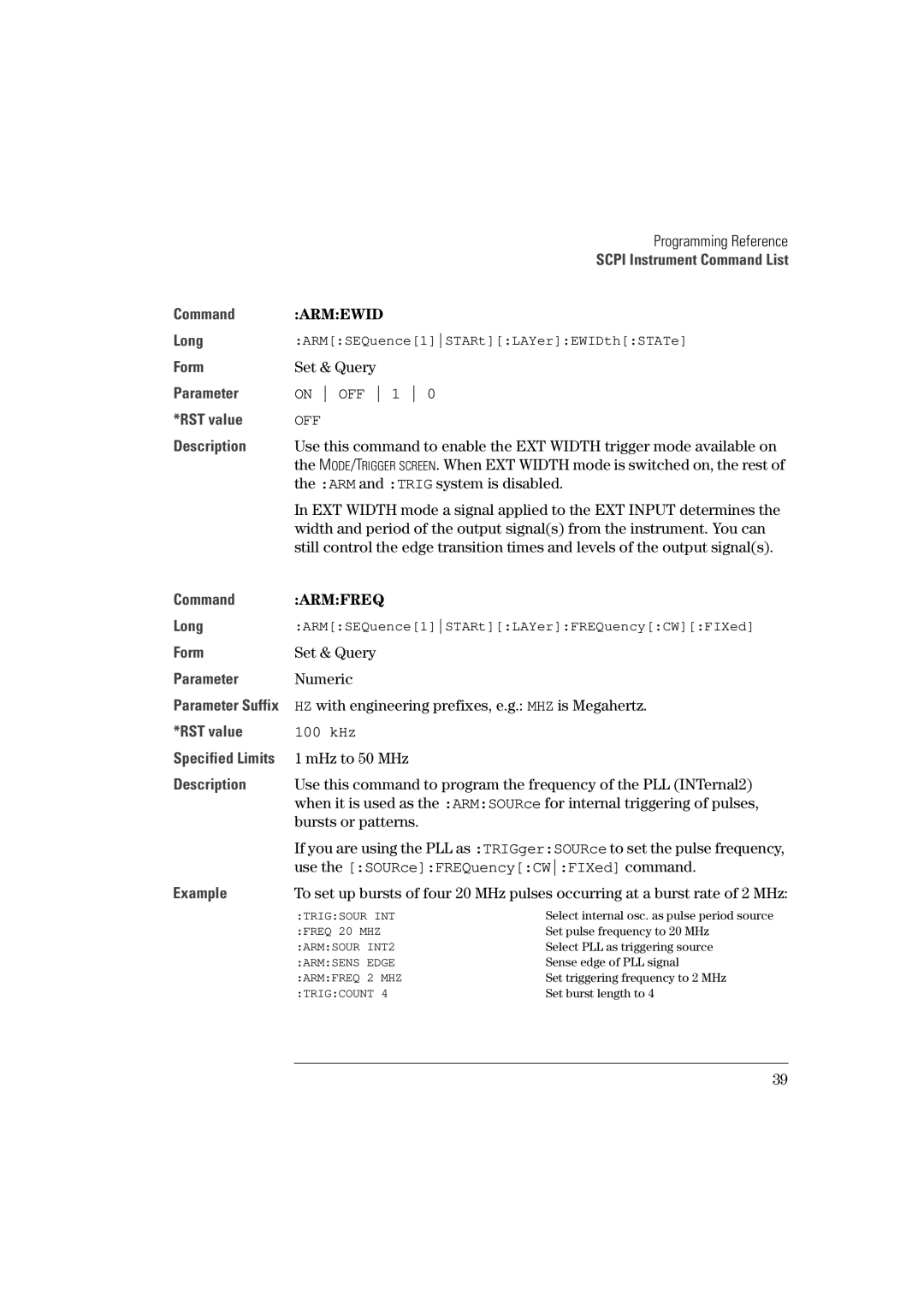Agilent 81101A 50 MHz Pulse Generator
Front Panel Display and Softkeys
Agilent 81101A 50 MHz Pulse Generator
Copyright
Limitation of Warranty
Safety Summary
Do Not Operate in an Explosive Atmosphere
Safety Symbols
About this Book
VOLTageHIGH
Contents
Contents
General Programming Aspects
GP-IB Interface Bus
Agilent 81101A Remote Control
Programming Recommendations
DISPlay OFF
SOURcePULSeDOUBle1STATe ONOFF. Sufficient to use
# enable the output
# set default settings
# switch off display update
# switch off error check
Command Parameter Description
Common Command Summary
Status Model
Condition Register
Transition Filters
Event Register
QUEStionable OPERation
Enable Register
Registers in Group Status Group CONDition
EVENt
Status Byte
Standard Event Status Group
Bit Description
OPERation Status Group
This Status Group is not used in the instrument
Always
Bit QUEStionable
QUEStionable Status Group
Programming Reference
See
Agilent 81101A Scpi Command Summary
High
DOUBle1 STATe
KEY
SET
Parameter RST, Default Values
Default Values, Standard Settings
Auto
KEY
LEVel SLOPe POSitive SOURce IMMediate
ARM Event detection layer
Programming the Instrument Trigger Modes
Continuous
Triggered
Gated
Pulse period Source TRIGger SOURce
External Width
Pulses
Burst
Scpi Instrument Command List
Armfreq
Use the SOURceFREQuencyCWFIXed command
Armewid
On OFF 1
Armlev
Armimp
Armper
10.00 ∝s
Ns to 999.5 s
Edge LEVel
Frequency of the arming signal
Signal
Armsens
Disp
Armsour
Mmemcdir
MMEMCAT?
Mmemcopy
Mmemdel
Mmeminit
Mmemloadstat
Mmemstorstat
Filename,A
50.0 Ω
To switch on the output
OUTP1IMP
OUTP1IMPEXT
OUTP1POL
NORMal INVerted
CURR1
CURR1OFFSet
To program the amplitude current of the output signal
Offset
OUTPutIMPedanceEXTernal
CURR1HIGH
SOURceCURRent subsystem
CURR1LOW
CURR1LIM
CURR1LIMSTAT
CURR1LIMLOW
Freq
Voltage or current
Use this command to enable either of the SOURceVOLTage or
Freqauto
Hold
SOURcePULSeDELay1HOLD PRATio
With SOURcePULSeDELay
Period is varied rather than the absolute pulse width use
PULSDCYC1
10.0% derived from width and period
001% to 99.9%, depends on width, transition & period
SOURcePULSeDELay1HOLD Time
PULSDEL1HOLD
Time PRATio
PULSDOUB1
To set the pulse delay to 50% of period
PULSDEL1UNIT
Parameter is programmed to a value without a unit suffix
SOURcePULSeDOUBle1DELayHOLD Time
To set and hold the double-pulse delay
PULSDOUB1DEL
PULSDOUB1DELUNIT
To set the double-pulse delay to 50%
PULSDOUB1DELHOLD
TIMEPRATio
Pulsper
PULSHOLD1
PULSTDEL1
Pulsperauto
Pulse width
To program the pulse width by means of the delay parameters
When the pulse width is varied
PULSTRAN1HOLD
PULSTRAN1
PULSTRAN1UNIT
To set the leading and trailing edges independently
PULSTRAN1TRA
PULSTRIG1VOLT
PULSTRAN1TRAAUTO
Roscsour
PULSWIDT1
MHz or 10 MHz
To set up the external PLL reference
Roscextfreq
MHz
SOURceVOLTage subsystem
Numeric Parameter suffix V with engineering prefixes
Specified current limits
VOLT1OFFSet
With Amplitude, see
To +10
To 10.0 V 50 Ω into 50 Ω
VOLT1HIGH
With low level, see
500 mV
To set the low level voltage
VOLT1LOW
With high level, see
To 9.9 V 50 Ω into 50 Ω
VOLT1LIMLOW
VOLT1LIM
Command STATusOPERation
VOLT1LIMSTAT
To set and activate the high and low voltage limits
PTR NTR
This command
Command STATusQUEStionable
Status Group Register
STATusQUEStionableNTRansition
STATusQUEStionableENABle
STATusQUEStionableEVENt?
STATusQUEStionableCONDition?
SYSTERR?
Systchec
No key pressed Query only
Systkey
No suffix allowed
Key Description
Softkey
Cursor Up Cursor Down Cursor Left Cursor Right
Command Systpres
Systsec
Systset
SYSTVERS?
SYSTWARN?
TRIGCOUNt
SYSTWARNSTR?
Separator between the messages
SYSTWARNBUFF?
50 Ω or 10 kΩ
Triggered by a positive edge at the EXT Input
EXT Input
Trigimp
Triglev
Trigslop
Trigsour
IMMediate INTernal1
Pulse period sources set by Trigsour
Pulse period source
TRIGSOURce
Scpi Instrument Command List
Warranted Performance
Temperature
Pulse Generator
Used by the instrument
Agilent 81112 a
Declaration of Conformity
Maximum Dimensions H x W x D
Agilent 81101A Specifications
Safety
Power requirements
Acoustic Noise Emission
Weight
Warranty
Recalibration period
Period Agilent 81101A
Period
Glitch-free timing changes
Period can also be entered as frequency
Width Agilent 81101A
Delay
Delay Agilent 81101A
Width
Transition Times Agilent 81101A
Double Pulse Delay
Double Pulse Delay Agilent 81101A
Transition Times
Level Parameters Agilent 81101A
External Load compensation
Pulse Performance Agilent 81101A
Level Specifications 50 Ω into 50 Ω 1k Ω into 50 Ω
Level Parameters
Pulse Performance
Phase Locked Loop PLL
Input Specifications Agilent 81101A
Clock / PLL Reference Input
Burst Parameters Agilent 81101A
Pulses Mode
Burst Mode
External Clock
Externally Triggered
Externally Gated
Generate continuous pulses, double pulses, or bursts
Strobe Output
Trigger Output Specifications Agilent 81101A
Strobe Output Specifications Agilent 81101A
Trigger Output
Typical Delays
Mode From Value
Typ
Memory Card
Overprogramming
Help Key
Non-Volatile Memory
SH1, AH1, T6, L4, SR1, RL1, PP0, DC1, DT1,C0
Function Code
Programming Times
Operates according to Ieee standard 488.2, 1987 and Scpi
105
Pulse Parameter Definitions
Pulse Width
Trigger Delay
Time Reference Point
Pulse Period
Pulse Delay
Interchannel Delay Skew
Interval between leading edge medians of the double pulses
Transition Time
Linearity
108
109
Jitter
Stability
Pulse Levels
Preshoot, Overshoot, Ringing
Settling Time
110
111
Repeatability
112
Gated
Symbols
113
Burst
114
Jitter
Period
115
Safety
116
Front Panel Controls
Page
Manual Changes
Model 81101A
Index of Manual Change Manual Frame Errata
Manual Change
Declaration of Conformity
